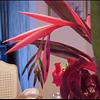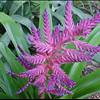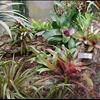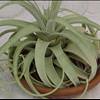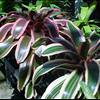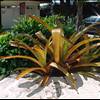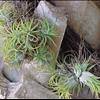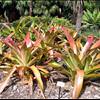This plant may be available to buy
Click the banana to see

|
click pics to enlarge |
|
Many more pics below in this article Bromeliads are desired for their foliage or unique flowers and sometimes, both. Most folks think of bromeliads as majestic, long-lasting bloomers We even eat bromeliads. All bromeliads are native to the Americas, mostly Central and South America but some in the USA. Even Spanish Moss is a bromeliad and native in Florida and other states. More Spanish photos #2 #3 including FLOWERS Here's another Florida native bromeliad, and another found on most trees and palms click pic to enlarge There are seven families and hundreds of varieties of bromeliads. The key is to know the native climate conditions and then provide a similar environment. Most want shade but some grow in full sun, happily click pic to enlarge Bromeliads are mostly epiphytic, so people potting them in "soil" is much more a holding medium rather than a feeding medium. Excellent water drainage is always a strict requirement in pots. Many folks in Florida have their bromeliads attached in tree limbs or on slabs of wood, like staghorn ferns. Some are right in the soil landscape So feeding is not really required but if you are using soil, time release pellets will boost appearance and blooming. Otherwise we like organics like fish emulsion Basically pest free (especially outdoors where rain washes away dust and bugs), anyone would enjoy a fine bromeliad for many years. Here's a favorite wholesale nursery featuring shade grown bromeliad selections Here are some professionally mounted bromeliads displayed at our annual plant industry show here in Fort Lauderdale 2010 Aechmea genus is very popular for leaves. Over 200 species grow on rocks or trees from Mexico to Argentina. Leaf edges have spines. Leaf color may be solid or speckled or look like bands
Aechmea Zebrina (variegated) Billbergia sports about 60 species of epiphytes, but often also can be held in a composite "soil" mix
Billbergia 'Hallelujah' Cryptanthus has nearly 50 species native to Brazil. Leaves generally grow flat left and right and the plant seems to look like a star with about 8 leaves. Leaves can be solid, striped or banded and their are many hybrids Guzmania love warm to hot temperatures, plenty of humidity and plenty of shade. About 180 species grows as epiphytes in rain forests of Columbia, Peru and Ecuador. One normally sees a multitude of long leaves which are spineless. Most Guzmanias grow as large plants
Guzmania 'Luna' Neoregelia are very popular as they are easy to grow and have plenty of color. The habit is compact rosette leaves with spines. About 50 species grow as epiphytes
Neoregelia 'Allure' Nidularium is native to Brazil and we know of about 60 species. Many grow on the ground next to trees or in the lower limbs of trees. Size ranges from small to large, leaves are spineless and many have fine inflorescences Nidularium 'Francois Spae' (red) Tillandsia if the largest genus with over 500 members. Native from the Southern USA with 12 species to Argentina in the Americas. Spanish Moss is in this family. Tillandsia leaves are often twisted in appearance and covered in grey-colored scales. Flowers may be significant in some species and some even sport fragrant flowers
Tillandsia tectorum Vriesea has about 300 species as epiphytes mostly in Brazil. Leaves are spineless and the inflorescences are often showy and most last several months
Vriesea imperialis, Pic #1
#2
#3 #4 #5 Most folks buy a bromeliad with a bloom. In time, sometimes months, perhaps only a week or two, the bloom fades and the original plant appears to be dying. It is Bromeliads take time, sometimes years, to form a bloom, then die. In its place, bromeliads produce pups (babies) at the soil line, sometimes a lot of pups. So, if you want more free plants, hang in there with your declining plant Wait until the pups are of substantial size, about 20% or more of the size of the original plant, then you may safely remove and re-plant. Pups may or may not have roots at these sizes. Removing with roots attached is even better, but not necessary. Roots will grow later Removing pups often encourages the mother plant to produce even more pups. Feel the mother plant and the pup. If they are very firmly attached to each other, use a knife to separate the pups On the other hand, you could do nothing. The parent plant will whither away over time and the babies will root well exactly where they were born. Once they are vigorous, you could remove the remains of the dead parent plant When you buy your bromeliad, you likely will see it potted in soil. This is fine as long as the soil is very well drained, otherwise, you get rotting roots and death. Except for Cryptanthus and Pitcairnioideae species, one may use soil for bromeliads. Pitcairnioideae are dyckias, hechtias, navias and pitcaririas Like staghorn ferns, many bromeliads can be mounted on wood slabs or into tree branches. Use a small amount of sphagnum moss at the root zone and attach to your slab. You can also skip using any sphagnum moss at all and just attach the plant/roots directly. Many prefer the "no moss" approach. Too much moss may make conditions too wet Use clean, untreated wood only (e.g. no plywood). The moss can be tied to the slab with fishing line. You can also use copper wire, coated wire or galvanized wire. One can also use "Liquid Nails" (hardware store) to glue a plant to wood or tree branch For watering, if your species has a "cup" in the center, the cup will hold water. If you have this type, keep water in the cup. Discard the water every two weeks or so and replenish with new pure water, rain water being the best. If your plant is in soil, once or twice a week watering likely will be fine, depending on temperatures and rainfall. Again, this assumes you have VERY well drained soil Although some bromeliads handle full sun, almost all like shade, outdoors. Something in the 50-75% shade range will work. Early morning sun is always OK. Best sun exposure is high broken shade from tall trees that allow broken sun to filter to the ground, e.g. Royal Poinciana is excellent for providing broken shade Indoors, bromeliads are great. You need to provide bright light, air circulation, clean water and warmth. Using indoor grow light to assist with light and light hours often is a fine enhancement to plant performance For feeding, we like to use fish emulsion fertilizer. Fish emulsion is organic, and will not burn Some rare varieties in pictures
Orthophytum navioides |
